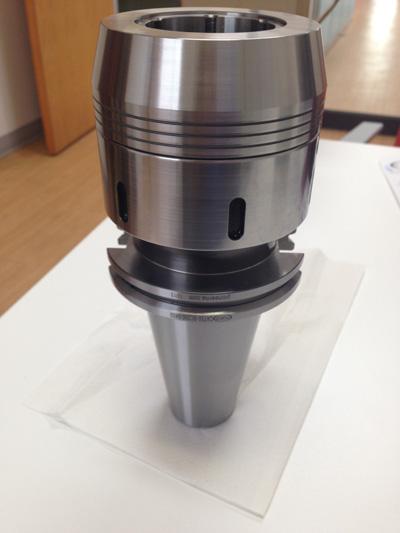
Pioneer announced two additional sizes in their recently launched BC Mill Chuck milling line. This bearingless, low profile chuck line now features 5⁄8" and ½" BC Chuck Holders.
"We take great pleasure in providing our customers with the precisely what they need to keep their businesses moving efficiently," said Pioneer Tool Holder Division Vice President, Lee Flick. "We're always working to design better, faster and smaller tools at an affordable price."
This size expansion increases Pioneer's inventory to include ½, 5⁄8, ¾, 1 and 1 ¼ inch chucks. The tool's design leads to a notable cost savings for the end-user by providing a more precise cut and increasing cutter efficiency, according to the company. The design also addresses customer issues inherent in traditional mill chuck designs.
Pioneer's new BC Mill Chuck Line is designed to provide a positive lock with no bearing to crush if over tightened. Its profile is substantially lower than competitive models and features a self-sealing bore design for high-pressure applications. It is also available with customized Jet-Blast modification, exclusive to Pioneer. Due to fewer moving parts in the design, the BC style Mill Chuck is easier to balance and more consistent in balance repeatability. The design lends itself well to be a more cost effective platform for special ID sizes and applications.
In addition to these standard sizes, Pioneer has developed a 2" BC Mill Chuck (pictured) and is currently offering three free samples for demonstration and testing.
Contact Details
Related Glossary Terms
- chuck
chuck
Workholding device that affixes to a mill, lathe or drill-press spindle. It holds a tool or workpiece by one end, allowing it to be rotated. May also be fitted to the machine table to hold a workpiece. Two or more adjustable jaws actually hold the tool or part. May be actuated manually, pneumatically, hydraulically or electrically. See collet.
- gang cutting ( milling)
gang cutting ( milling)
Machining with several cutters mounted on a single arbor, generally for simultaneous cutting.
- inner diameter ( ID)
inner diameter ( ID)
Dimension that defines the inside diameter of a cavity or hole. See OD, outer diameter.
- milling
milling
Machining operation in which metal or other material is removed by applying power to a rotating cutter. In vertical milling, the cutting tool is mounted vertically on the spindle. In horizontal milling, the cutting tool is mounted horizontally, either directly on the spindle or on an arbor. Horizontal milling is further broken down into conventional milling, where the cutter rotates opposite the direction of feed, or “up” into the workpiece; and climb milling, where the cutter rotates in the direction of feed, or “down” into the workpiece. Milling operations include plane or surface milling, endmilling, facemilling, angle milling, form milling and profiling.
- milling machine ( mill)
milling machine ( mill)
Runs endmills and arbor-mounted milling cutters. Features include a head with a spindle that drives the cutters; a column, knee and table that provide motion in the three Cartesian axes; and a base that supports the components and houses the cutting-fluid pump and reservoir. The work is mounted on the table and fed into the rotating cutter or endmill to accomplish the milling steps; vertical milling machines also feed endmills into the work by means of a spindle-mounted quill. Models range from small manual machines to big bed-type and duplex mills. All take one of three basic forms: vertical, horizontal or convertible horizontal/vertical. Vertical machines may be knee-type (the table is mounted on a knee that can be elevated) or bed-type (the table is securely supported and only moves horizontally). In general, horizontal machines are bigger and more powerful, while vertical machines are lighter but more versatile and easier to set up and operate.
